Teenagers in many countries look forward to the day they get the freedom of their driver’s licence, letting them explore their increasingly widening world. In rural and suburban Japan, where trains and busses may not be reliable or common, this freedom is given form in a moped, scooter, and motorbike licence, obtainable at the age of 16. Current anime Super Cub, based on a novel series of the same name, is a love letter to this first flush of adolescent freedom.
The Super Cub anime opens with main character Koguma, a quiet and lonesome girl who lives alone on a meager income in a very rural part of Japan called Yamanashi. This area is known for its natural beauty, including being one of the prefectures that contains Mount Fuji. Despite the fact that 27% of Yamanashi is designated as national parks, Koguma has seen very little of it beyond the route she takes on her bicycle from her apartment to her high school and back again.
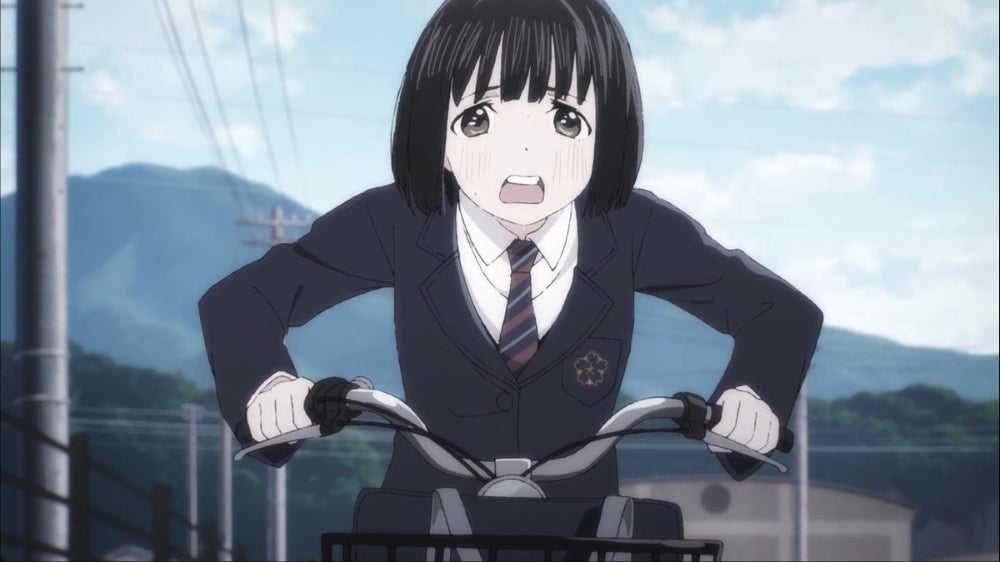
By her own admission, Koguma has little interest in her world or the people around her. She has no family, no friends, no hobbies, and no possessions beyond basic furniture, kitchen appliances, school clothing, discount food, and her bicycle. She’s an orphan, though we’re never told and what happened, and we can see the effect it’s had on her life. Perhaps a part of her died when her parents did, her trauma turning her into the walking dead.
The animation is simple and clean cut, with colours that are washed out but not disorienting. The animators do an excellent job representing rural streets, fields, and hills, as well as the typical modifications necessary to accurately portray real brands of convenience stores, supermarkets, and car dealerships. This really feels like the rural Japan I know from living in Kyoto and Gunma prefectures.
The first spark of personality we see from Koguma is in the first episode, as she struggles to ride up the hill to her school on her bicycle and seems annoyed at the ease with which a classmate passes her on a modern moped. Unable to shake the thought, she pedals to a nearby scooter shop but is dismayed by the high prices (in the 100s of 1000s of yen, or 1000s of US dollars).
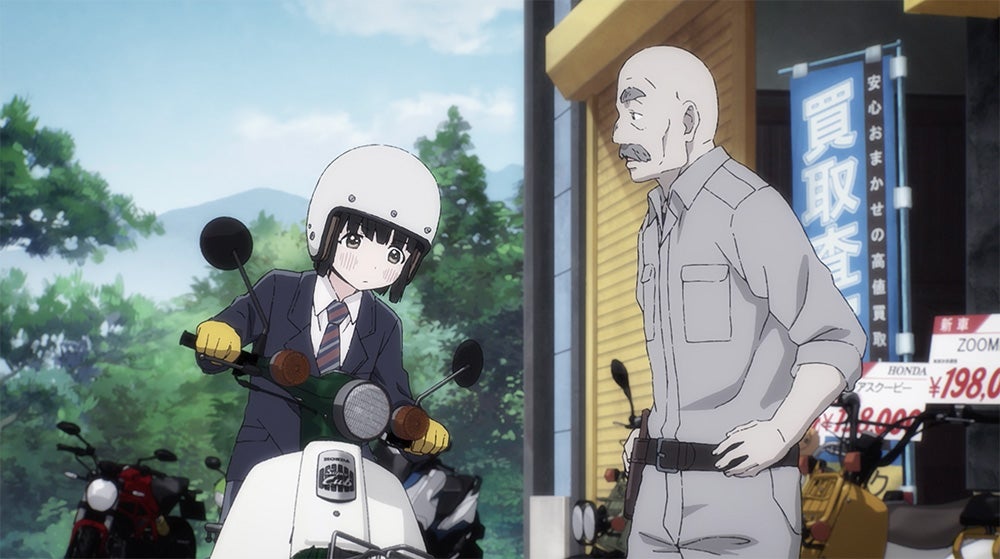
Noting her sadness and resignation, the shopkeeper suggests an old, restored Honda Super Cub motorcycle that costs 10,000 yen, or just under a hundred bucks.
Clearly tempted, she takes a seat on the Super Cub. And her world (and ours) changes. A breeze blows, and the colours wash back in, vibrant and bright. Just for a moment, there is an awareness that there’s something magical about this old motorbike. Koguma can feel it; so can we. This change in saturation will be repeated throughout the series each time Koguma discovers something new.
The world fades again. She’s understandably suspicious and asks bluntly why the bike is so cheap. The shopkeeper informs her sadly that the vehicle was in a fatal accident and that no one in the small town will buy it. Koguma is nonplussed and agrees to purchase it. Perhaps her own family loss made her numb to feelings other buyers might not be able to shake.
After Koguma gets her licence, and wearing a new set of helmet and gloves, she takes the Super Cub for its first official ride. The world is in colour for her and for us once more. Where before she had nothing — no family, no friends, no hobbies, and no genuinely loved possessions — now she has her Super Cub. She’s not above staring at it like a pet. She’s barely gotten it home before she’s fallen in love.
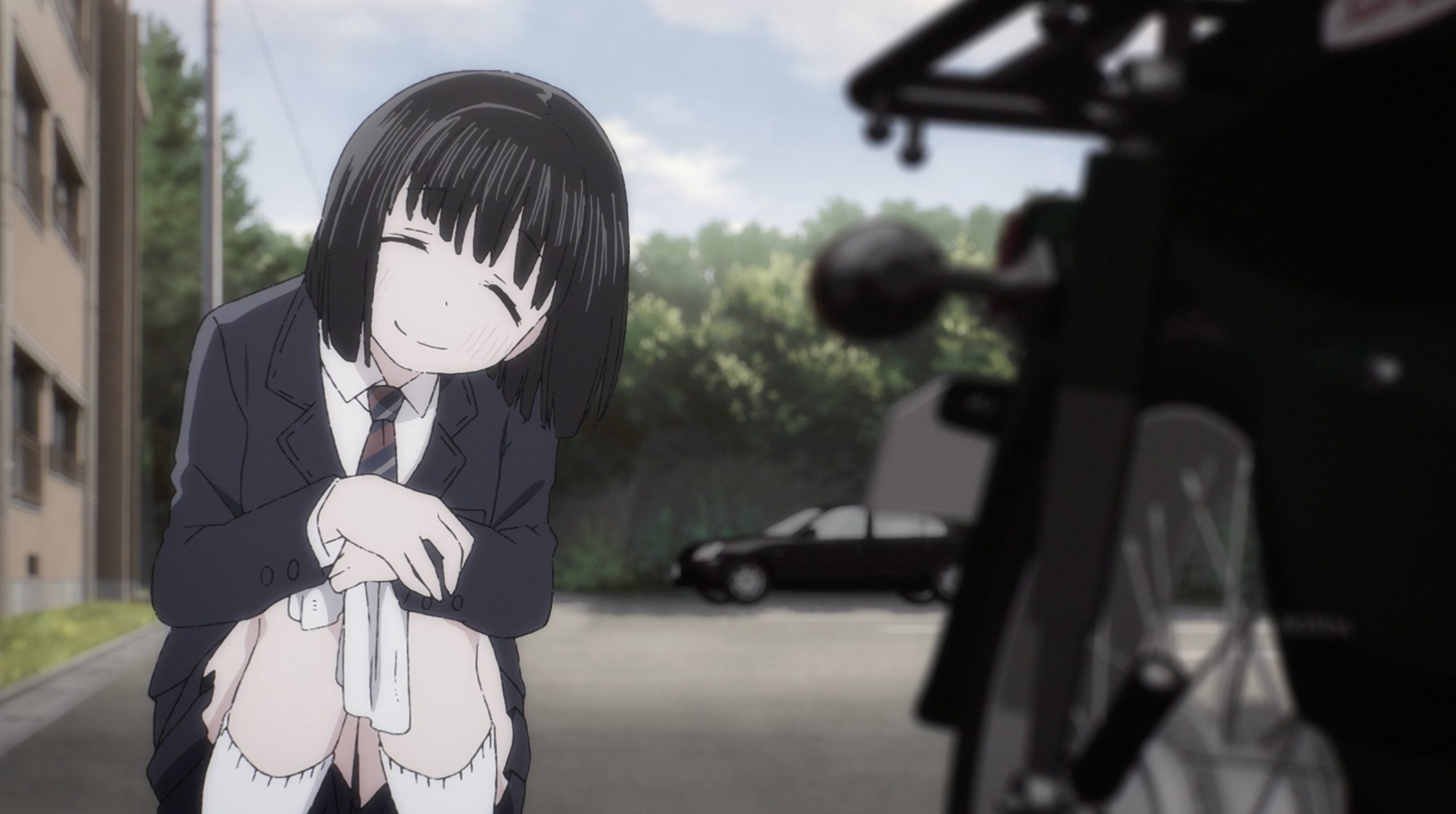
Super Cub isn’t really about the Super Cub; it’s about what the Super Cub represents. It represents freedom and choice, adventure, and a world of possibility and exploration. It represents that to Koguma’s peers as well. Koguma rolls into class, her pride palpable, and loudly announces, “I HAVE A MOTORBIKE NOW!” And not only do her peers react with surprise that she speaks, but it makes her instantly popular. Some of her classmates are dismissive — it’s only an old Cub — but others are obviously jealous of her newfound mobility.
I remember when I got my driver’s licence at 15, a provisional licence that had restrictions on how far I could go, who I could have with me in the car, and what locations I could visit. Despite all this, it was still so much farther, so much faster, than I ever could have gone before. I remember how triumphant I felt the first time I drove to school, pulled up to a parking spot near the busses in my almost-new 1998 emerald green Ford Escort ZX2 (with Revolutionary Girl Utena rose crests on it, no less!) in front of all my peers, and watched their jaws drop as they exited the yellow tube of horrors. I’d have all sorts of problems with that car, but on that day, I might as well have just pulled in with a McLaren. Any wheels are good wheels when you’re 15 and your friends can’t drive yet.
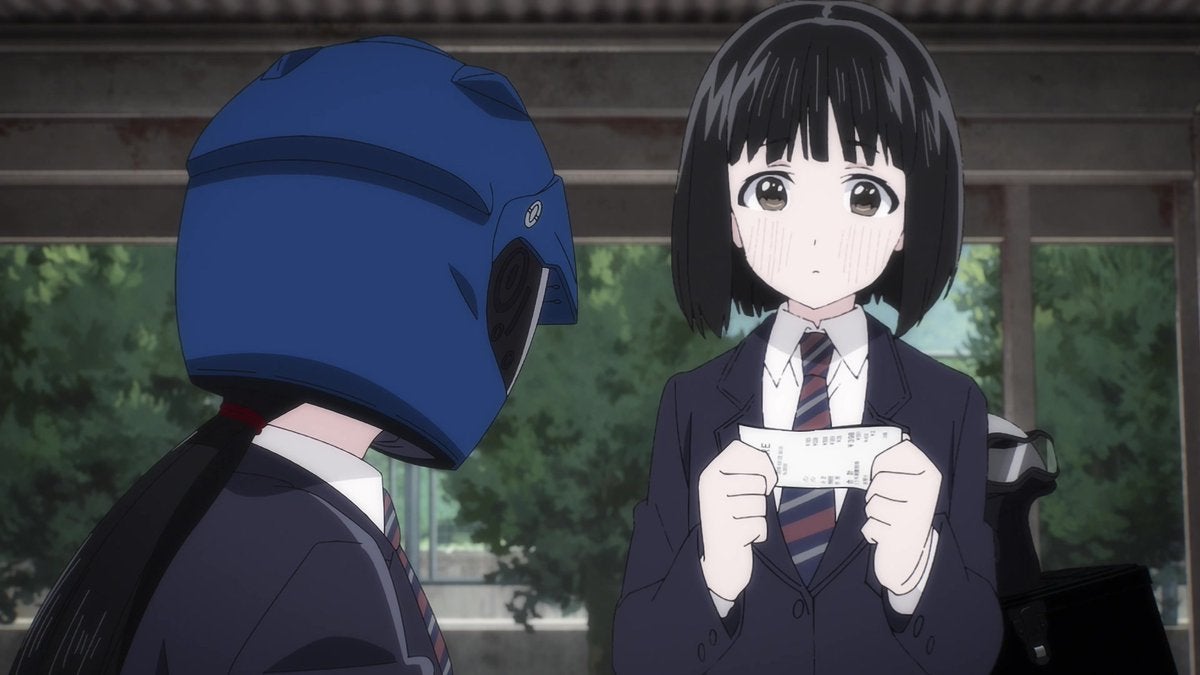
My own world became a lot more colourful that day; it’s when my love affair with cars started. As Super Cub progresses, we see Koguma have this same experience. Realising the full extent of her freedom comes in fits and starts. She meets her first friend, a confident Cub “otaku” named Reiko. Reiko has a modified Postal Cub, a Super Cub sibling used by postal carriers in Japan. She quickly becomes Koguma’s guide to the world of Cubs and helps Koguma expand her awareness of her new-found freedoms.
When speaking to Kotaku’s Brian Ashcraft about the series, we shared concerns that Super Cub will turn into nothing but animated commercials for Honda. So far, though, I think our concerns were misplaced. Past the halfway point in the series, the focus primarily seems to be on the outcomes of an increase in mobility. Sure, the show’s aspirational quality is also common in advertising, (“use our product, and good things will happen!”), but there are many potential substitutions for a Super Cub, and the series doesn’t seem to be arguing that the Cub is better than any other bike.
That said, Cubs are no longer made in Japan, but I wonder if Super Cub will drive sales of Cubs in Southeast Asia or worldwide, as well as encourage younger people, like Koguma and Reiko, to join Japan’s robust and vibrant Cub subculture. The subculture aspect, and the way it brings Koguma and Reiko together, is a huge part of the series so far.
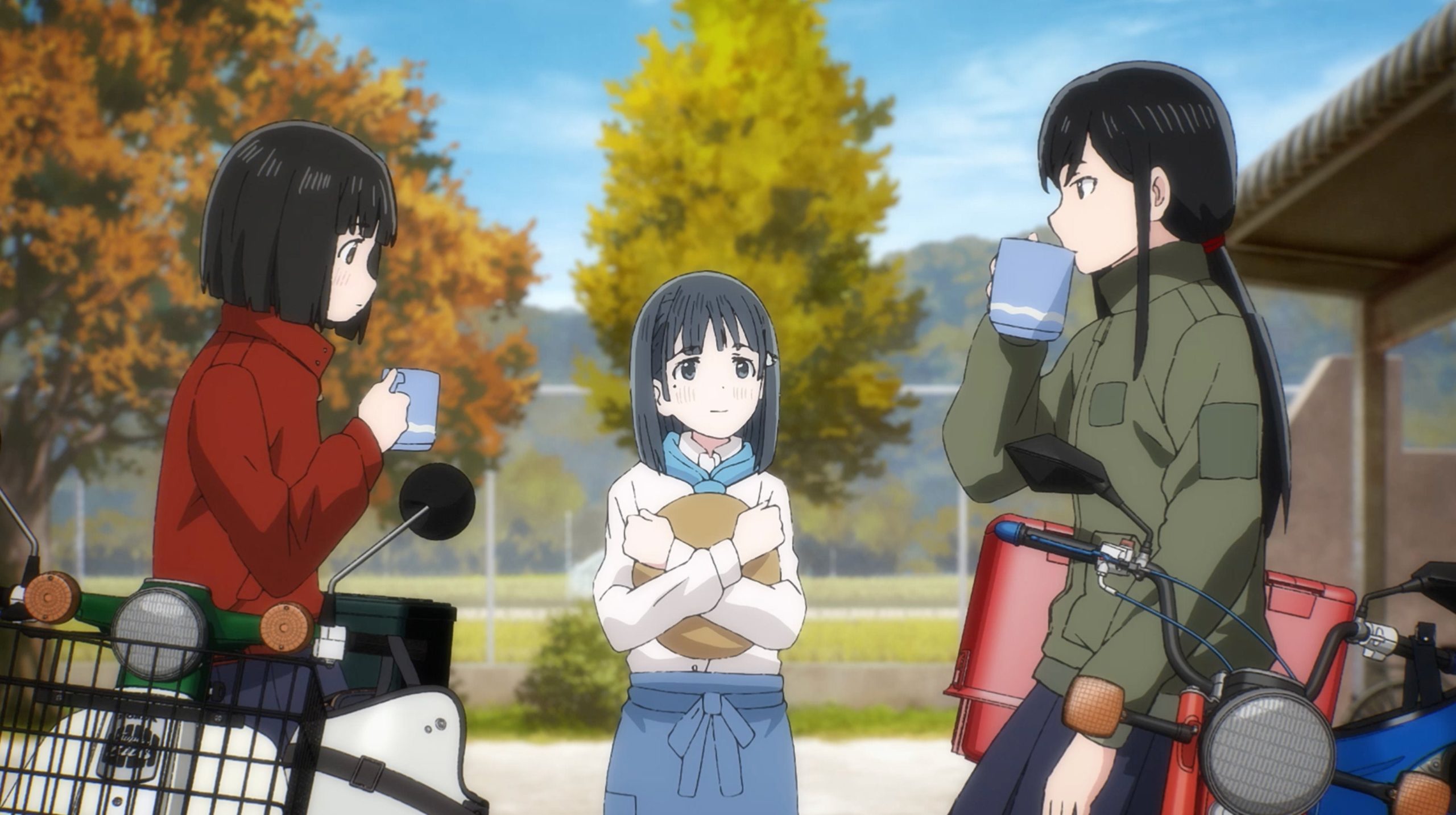
Not only does Koguma’s friendship deepen with Reiko over their shared connection of owning Cubs, but through Reiko and her Cub, Koguma meets others. These new friends include a teacher at another high school, where her Cub allows her the part-time job of shuttling documents between schools, and a classmate named Shii who requires Koguma and Reiko to do a last minute run to pick up supplies for the school’s culture festival. (Reiko eventually replaces her Postal Cub with a Hunter Cub after she wrecks it trying to drive it up Mount Fuji.)
I own a 2009 Honda Fit RS, and after the first episode, I wanted to run out and purchase a Super Cub. Admittedly, I’m a Honda fan, but with each subsequent episode, my desire for this decades-old scooter has only grown. There’s a lot of Japan I still haven’t seen, and as the months grow warmer and summer comes, there are far worse ways to see it than on the back of a Cub. I imagine many 16- and 17-year-olds watching the series might feel the same.
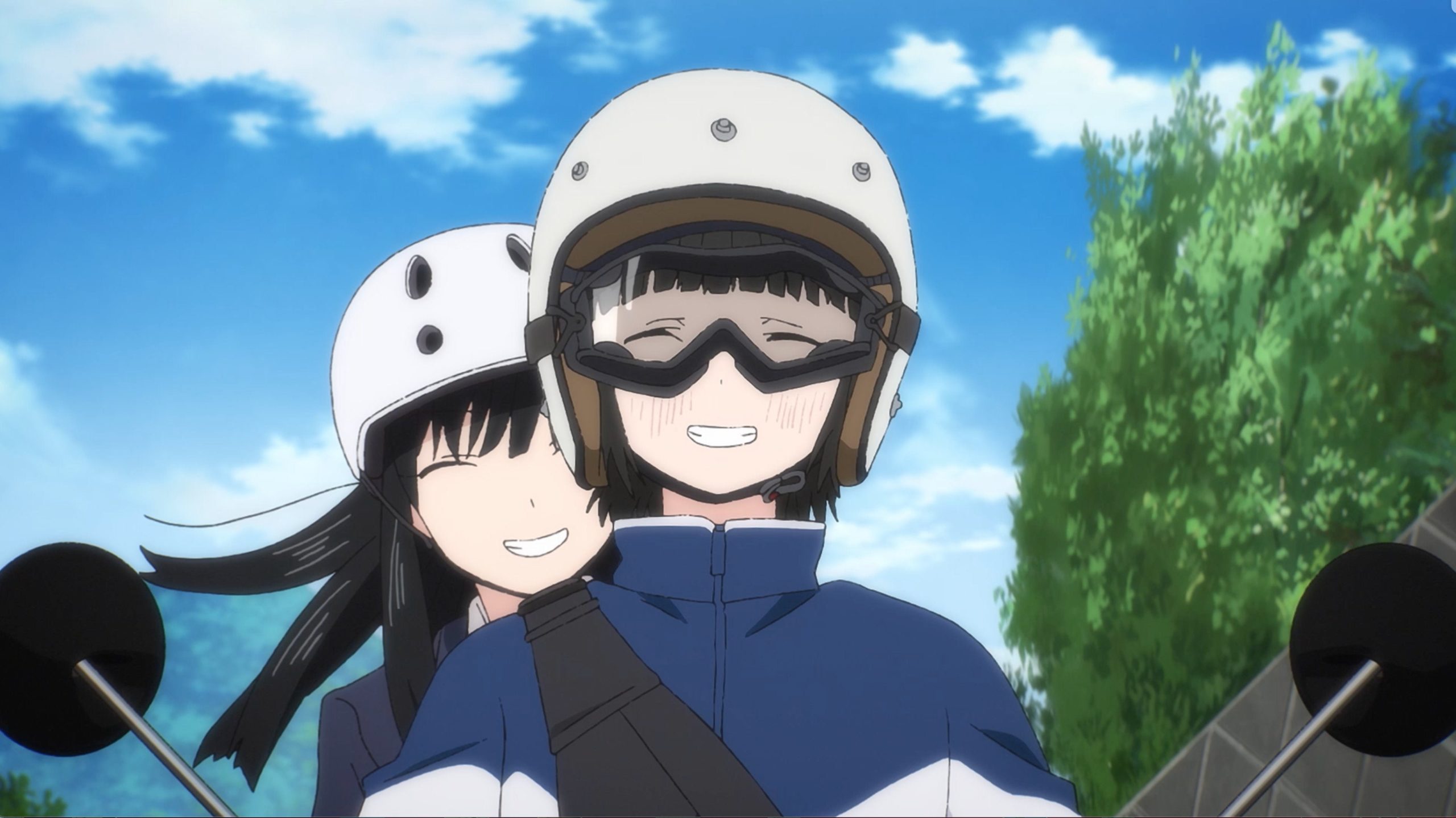
With Yamanashi being the perfect backdrop for those feelings, I’m looking forward to seeing Koguma and Reiko putter around the roads, through mountains and valleys, along rivers and beaches. There is so much for them to discover; so much freedom to be felt. I can’t wait to see where their Cubs will take them — and take us in the process.
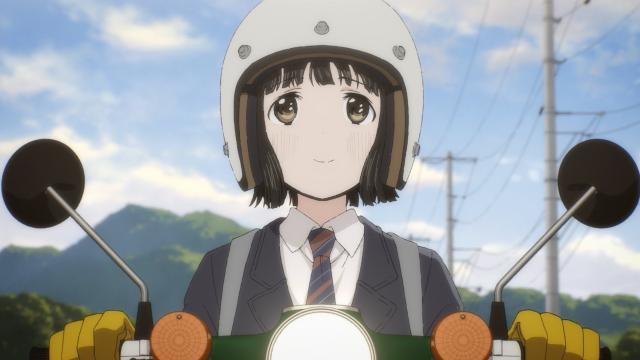
Leave a Reply